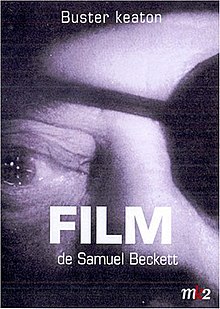Film (film)
| Film | |
|---|---|

Film by Samuel Beckett
|
|
| Directed by | Alan Schneider |
| Written by | Samuel Beckett |
| Starring | Buster Keaton |
| Cinematography | Boris Kaufman |
| Edited by | Sidney Meyers |
| Distributed by | Milestone Film & Video, Inc. |
|
Release date
|
Italy September 4, 1965 (Venice Film Festival) USA January 8, 1966 |
|
Running time
|
24 minutes |
| Country | United States |
| Language | English |
Film is a 1965 short film written by Samuel Beckett, his only screenplay. It was commissioned by Barney Rosset of Grove Press. Writing began on 5 April 1963 with a first draft completed within four days. A second draft was produced by 22 May and a 40-leaf shooting script followed thereafter. It was filmed in New York City in July 1964.
Beckett’s original choice for the lead – referred to only as “O” – was Charlie Chaplin, but his script never reached him. Both Beckett and the director Alan Schneider were interested in Zero Mostel and Jack MacGowran. However, the former was unavailable and the latter, who accepted at first, became unavailable due to his role in a "Hollywood epic." Beckett then suggested Buster Keaton. Schneider promptly flew to Los Angeles and persuaded Keaton to accept the role along with "a handsome fee for less than three weeks' work."James Karen, who was to have a small part in the film, also encouraged Schneider to contact Keaton.
The filmed version differs from Beckett's original script but with his approval since he was on set all the time, this being his only visit to the United States. The script printed in Collected Shorter Plays of Samuel Beckett (Faber and Faber, 1984) states:
It was remade by the British Film Institute (1979, 16 mm, 26 minutes) without Beckett’s supervision, as Film: a screenplay by Samuel Beckett. David Rayner Clark directed Max Wall.
It first appeared in print in Eh Joe and Other Writings (Faber and Faber, 1967).
Throughout the first two parts almost everything is seen through the eye of the camera (designated in the script as E), although there are occasional moments when O's perception is seen. In the third part, much more of O’s perception of the room and its contents is given. In order to distinguish between the two perceptions, objects seen by O were shot through a lens-gauze, blurring his perception while E's perception was shot without gauze or filters, keeping the images sharp.
...
Wikipedia
